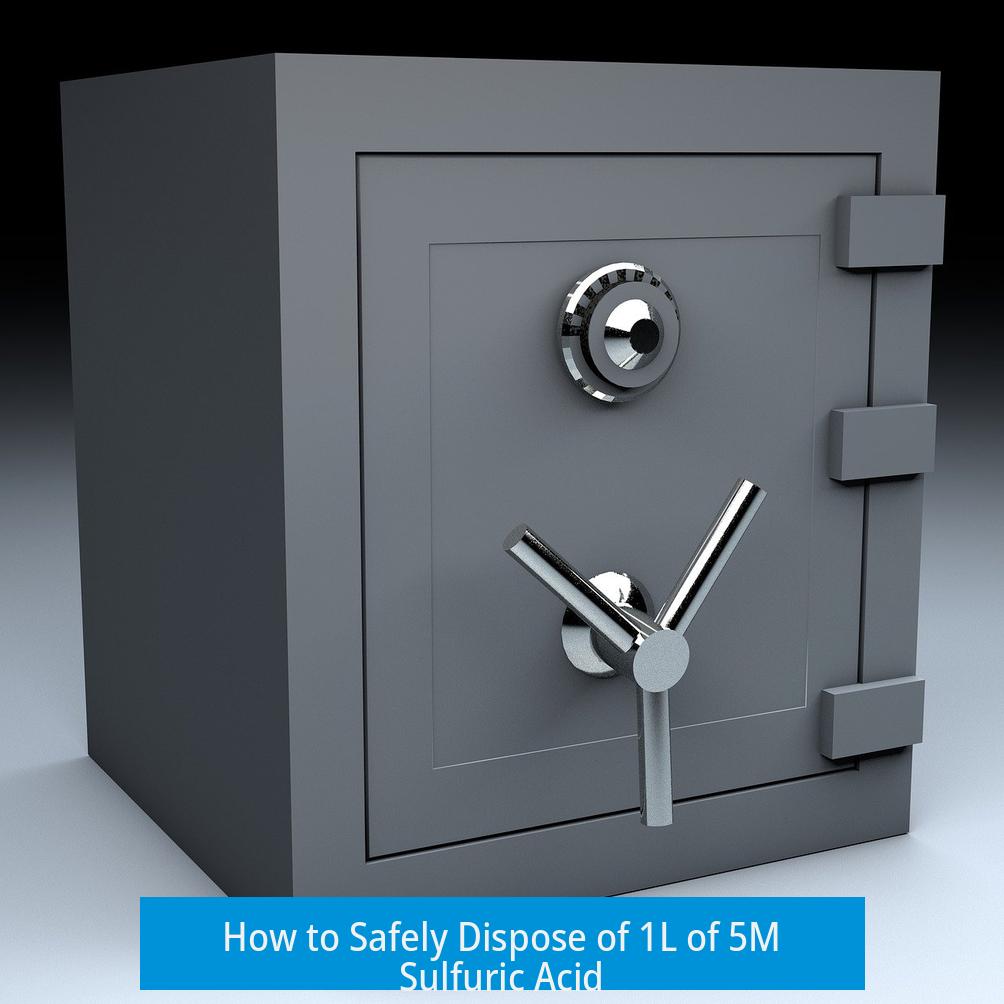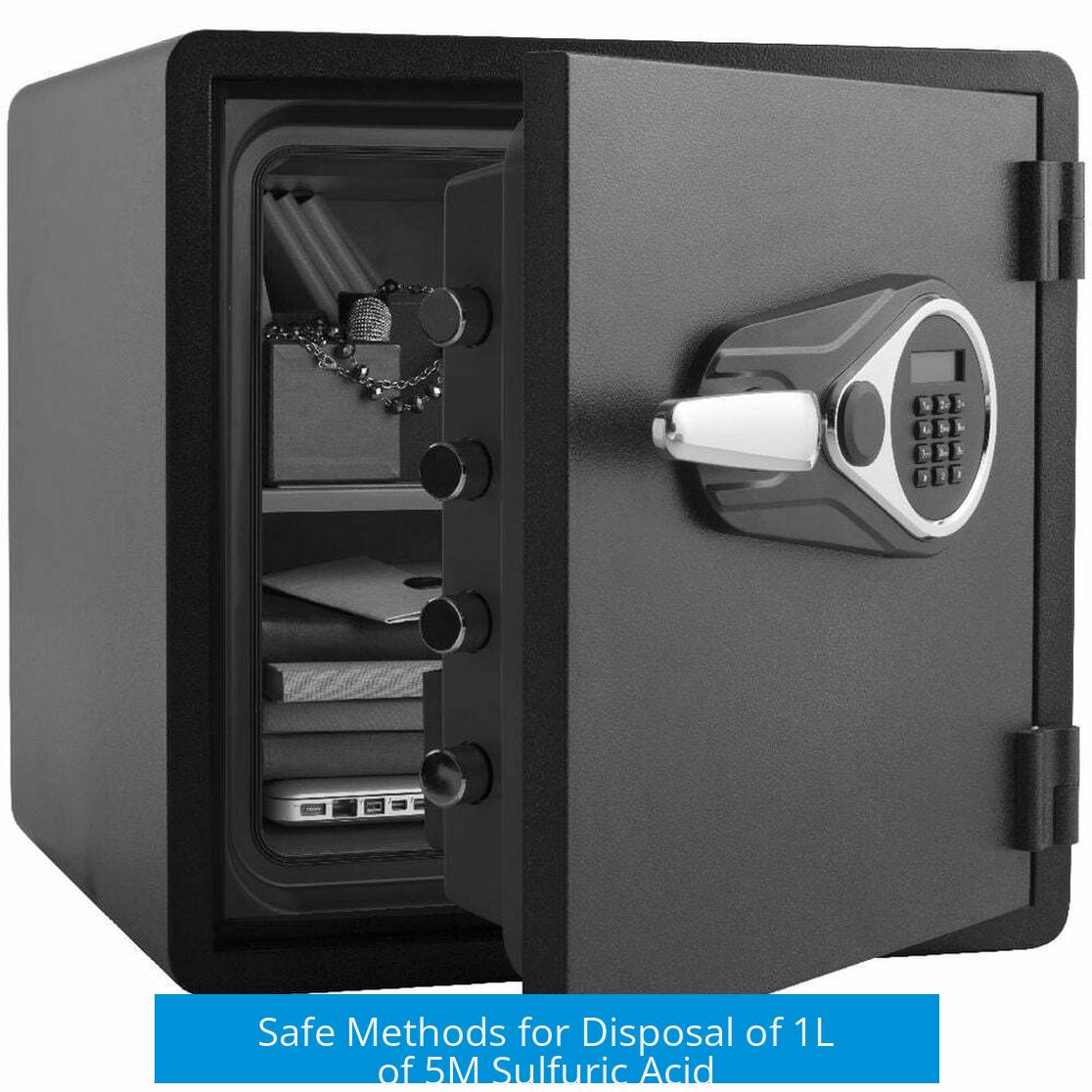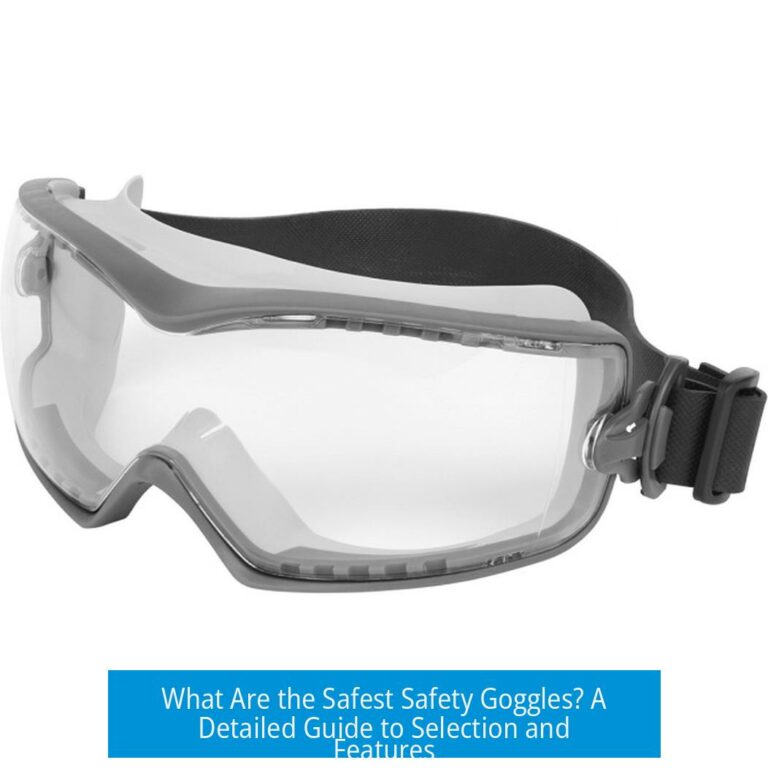How to Safely Dispose of 1L of 5M Sulfuric Acid

To safely dispose of 1 liter of 5M sulfuric acid, the safest method is careful dilution and neutralization followed by disposal through a drain with running water or using local hazardous waste services. Proper handling, person protection, and observation are critical to avoiding hazards during the entire procedure.
General Safety Precautions
Handling sulfuric acid requires protective gear. Use arm-length gloves, safety goggles, and work in a well-ventilated space. Always prevent direct contact with skin and eyes to avoid burns.
- Never add water directly onto acid; always add acid slowly to water.
- Wear plastic gloves and eye protection at all times.
- Monitor the temperature of the container to avoid overheating during reactions.
Heating happens because acid dilution is exothermic. Stop stirring if the container gets warm. This prevents splashing or violent reactions.
Dilution Method
The first step involves diluting the sulfuric acid to reduce its strength and hazards. Use a container large enough to accommodate the final volume safely—typically a 10–20L plastic bucket or a robust glass container.
- Fill the container halfway with cold water.
- Slowly add the 1L of 5M sulfuric acid to the water, not vice versa.
- Stir gently using a plastic or glass rod to mix the solution evenly.
Adding acid to water avoids rapid heat generation that occurs when adding water directly to acid. The diluted acid at this concentration is safer to manage and easier to neutralize or dispose of.
Neutralization with Sodium Bicarbonate
Neutralizing the acid transforms it into harmless salts and water. Sodium bicarbonate is an effective neutralizer but requires patience to prevent vigorous bubbling.
- Place a large amount of sodium bicarbonate (at least 2–3 pounds) in a bucket.
- Add the diluted acid very slowly to the bicarbonate.
- Allow the reaction bubbles to subside completely before adding more acid.
- Stir gently but continuously to prevent acid pockets.
- Check the pH regularly with test strips until the solution reaches a neutral range of 5–8.
This slow titration prevents excessive heat buildup and splashes. The reaction produces carbon dioxide bubbles, so work in a ventilated area.
After neutralization, the solution contains mainly water and sulfate salts, which are substantially less hazardous and safe for disposal down the drain.
Disposal via Drain with Running Water
Sulfuric acid, even at moderate concentration like 5M, is often used as a drain cleaner. Properly diluted and neutralized acid can be poured safely down household drains.
- Flush the drain with plenty of running water before disposal.
- Slowly pour the neutralized acid solution down the drain.
- Run the tap continuously for several minutes as the solution drains.
This process ensures acids dilute further in the plumbing system, neutralizing progressively before entering sewer lines. Sulfuric acid reacts with common compounds in pipes, reducing corrosion risks.
Wear gloves to protect your hands during this process. Avoid pouring acid directly into soil or outdoor areas as it may harm the environment if not properly neutralized.
Alternative Neutralization: Using Limestone or Chalk
Limestone or chalk is an effective neutralizer for sulfuric acid. The reaction forms gypsum, a harmless solid.
- Fill a large container partially with water.
- Add the 1L of 5M sulfuric acid slowly.
- Add about 2 kg of limestone or chalk chunks.
- Allow the mixture to fizz and settle, wearing gloves and eye protection.
This method is practical for neutralization without chemicals like sodium bicarbonate but requires handling and disposal of the solid gypsum formed after reaction.
Using Local Hazardous Waste Disposal
Some municipalities provide chemical disposal services. If uncertain or unwilling to handle the disposal yourself, contact local waste management facilities.
- Most local waste management centers accept household hazardous chemicals safely.
- They may offer free pickup or drop-off services for chemicals like sulfuric acid.
- This is the preferred option if access to water drain disposal is limited or restricted.
Always store the acid in a labeled, corrosion-resistant container while awaiting disposal. Never mix acids with incompatible chemicals.
Common Myths and Practical Notes
There is a misconception that small amounts of sulfuric acid cause extreme danger instantly. While it is corrosive and requires caution, moderate concentrations like 5M do not generate excessive heat upon dilution.
Neutralization does require patience due to bubbling reactions but avoids hazardous splashing.
Disposal on soil or outdoors is not recommended. Acid may disrupt soil chemistry and harm organisms.
Summary: Key Points to Safely Dispose of 1L of 5M Sulfuric Acid
- Always add acid to water, not water to acid to prevent heat buildup.
- Wear personal protective equipment including gloves and goggles during all steps.
- Slowly dilute acid in a large container to reduce concentration safely.
- Neutralize using sodium bicarbonate or limestone, monitoring pH carefully.
- Dispose of the neutralized solution down the drain with plenty of running water.
- Use local hazardous waste disposal services if available for safer management.
- Avoid pouring acid directly on soil or improper locations.
Careful adherence to these steps ensures safe, responsible handling and disposal of sulfuric acid in home or laboratory settings. The practices described minimize risk to people and the environment while complying with standard chemical safety principles.
How should I start the disposal process for 1L of 5M sulfuric acid?
Begin by wearing protective gear like gloves and safety goggles. Always add the acid slowly to plenty of water. Use a large plastic or glass container for dilution and stir gently with a plastic utensil.
Is neutralizing 5M sulfuric acid with sodium bicarbonate recommended?
You can neutralize it by slowly adding acid to a large amount of sodium bicarbonate. Wait for bubbling to slow, then test pH until it reaches 5-8. But for 5M acid, dilution is usually simpler and safer.
Can I pour diluted sulfuric acid down the drain?
Yes. Once diluted appropriately, slowly pour it down the drain with running water. Sulfuric acid breaks down quickly and neutralizes itself in pipes. Always rinse well afterward.
What volume of water should I use to dilute 1L of 5M sulfuric acid?
Use a large bucket (about 20 liters) and fill it halfway with water. Add the acid slowly to the water to avoid heat build-up. Stir carefully and keep an eye on temperature.
Are there safer alternatives to neutralization and dilution for disposal?
You can give the acid to local hazardous waste management for proper disposal. Many municipalities offer free pick-up or drop-off services for chemicals like sulfuric acid.





Leave a Comment